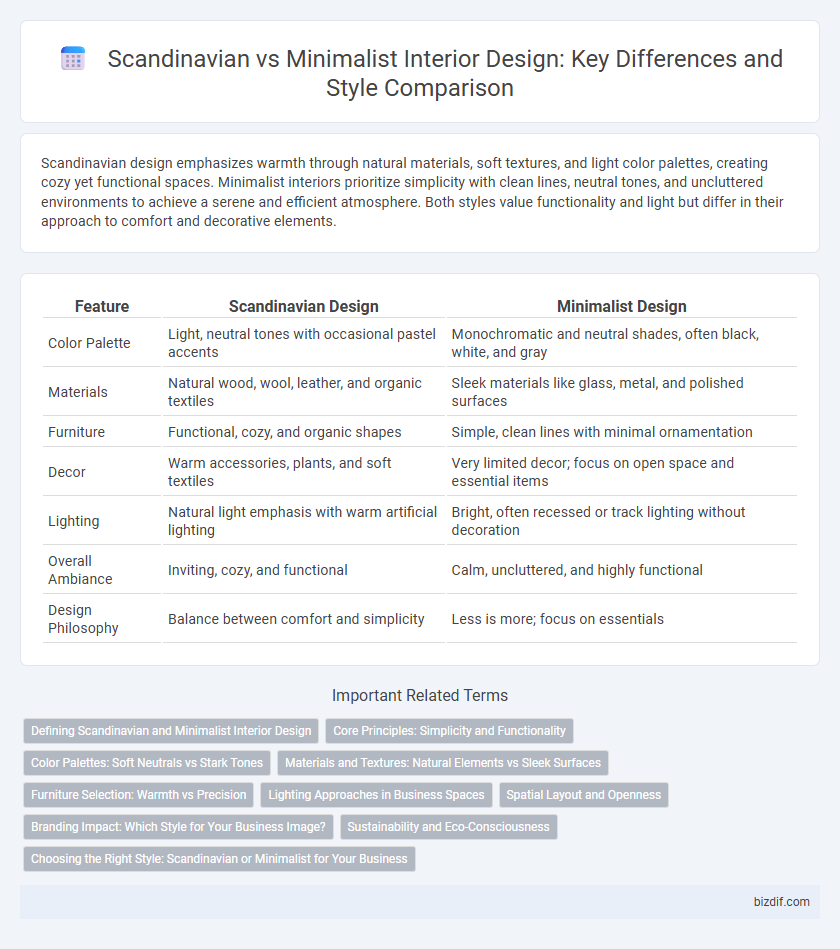Scandinavian design emphasizes warmth through natural materials, soft textures, and light color palettes, creating cozy yet functional spaces. Minimalist interiors prioritize simplicity with clean lines, neutral tones, and uncluttered environments to achieve a serene and efficient atmosphere. Both styles value functionality and light but differ in their approach to comfort and decorative elements.
Table of Comparison
| Feature | Scandinavian Design | Minimalist Design |
|---|---|---|
| Color Palette | Light, neutral tones with occasional pastel accents | Monochromatic and neutral shades, often black, white, and gray |
| Materials | Natural wood, wool, leather, and organic textiles | Sleek materials like glass, metal, and polished surfaces |
| Furniture | Functional, cozy, and organic shapes | Simple, clean lines with minimal ornamentation |
| Decor | Warm accessories, plants, and soft textiles | Very limited decor; focus on open space and essential items |
| Lighting | Natural light emphasis with warm artificial lighting | Bright, often recessed or track lighting without decoration |
| Overall Ambiance | Inviting, cozy, and functional | Calm, uncluttered, and highly functional |
| Design Philosophy | Balance between comfort and simplicity | Less is more; focus on essentials |
Defining Scandinavian and Minimalist Interior Design
Scandinavian interior design emphasizes functionality, simplicity, and natural elements, featuring light color palettes, clean lines, and cozy textures to create warm, inviting spaces. Minimalist interior design focuses on extreme simplicity and the elimination of excess, using monochromatic colors, open spaces, and essential furniture to achieve a clutter-free, serene environment. Both styles prioritize clean aesthetics but Scandinavian design incorporates more warmth and natural materials, while Minimalism centers on stark simplicity and minimal decor.
Core Principles: Simplicity and Functionality
Scandinavian and Minimalist interior design both emphasize simplicity and functionality, but Scandinavian design incorporates warmth through natural materials and cozy textiles, creating inviting, livable spaces. Minimalist design focuses on reducing elements to their essential forms, highlighting clean lines and uncluttered environments for a sense of calm and order. Both styles prioritize practical layouts and muted color palettes, enhancing the balance between aesthetic appeal and everyday usability.
Color Palettes: Soft Neutrals vs Stark Tones
Scandinavian interior design features soft neutrals such as warm beiges, muted grays, and pastel blues, creating a cozy and inviting atmosphere inspired by Nordic landscapes. Minimalist design emphasizes stark tones like crisp whites, deep blacks, and bold grays, promoting a clean, uncluttered look with high contrast. The choice between these palettes impacts the room's mood, with Scandinavian soft hues fostering warmth and minimalism's sharp tones enhancing simplicity and focus.
Materials and Textures: Natural Elements vs Sleek Surfaces
Scandinavian interior design emphasizes natural materials such as light woods, wool, and linen, creating a warm, tactile ambiance through textured textiles and organic finishes. Minimalist design prioritizes sleek surfaces with polished metals, glass, and smooth, matte finishes, aiming for simplicity and a clean aesthetic. The contrast lies in Scandinavian's embrace of natural, raw elements versus Minimalist's focus on refined, unembellished materials.
Furniture Selection: Warmth vs Precision
Scandinavian furniture selection emphasizes warmth through natural wood tones, soft textiles, and organic shapes, creating inviting, cozy spaces. Minimalist furniture prioritizes precision with clean lines, sleek materials like metal and glass, and a restrained color palette that enhances simplicity and functionality. Both styles utilize furniture to define spatial experience, with Scandinavian focusing on comfort and Minimalism on clarity.
Lighting Approaches in Business Spaces
Scandinavian lighting in business spaces emphasizes natural light and warm, ambient fixtures that create a cozy yet functional environment, often incorporating large windows and pendant lamps with soft bulbs. Minimalist lighting focuses on sleek, integrated fixtures with clean lines and strategic placement, using recessed or track lighting to highlight architectural features without clutter. Both styles prioritize efficiency and comfort but differ in their approach to warmth and visual texture through lighting choices.
Spatial Layout and Openness
Scandinavian interior design emphasizes functional spatial layout with cozy, multi-use areas that promote warmth and comfort while maintaining openness through light colors and natural materials. Minimalist design prioritizes simplicity and uncluttered spaces, using clean lines and open floor plans to create a sense of airiness and maximum spatial efficiency. Both styles value openness but differ in warmth, with Scandinavian inviting natural elements and Minimalist focusing on stark, streamlined aesthetics.
Branding Impact: Which Style for Your Business Image?
Scandinavian interior design emphasizes warmth, natural materials, and functionality, creating a brand image that feels inviting and approachable, ideal for businesses aiming to foster customer trust and comfort. Minimalist design highlights simplicity, clean lines, and uncluttered spaces, projecting a modern, sophisticated, and efficient brand identity that appeals to companies seeking to convey innovation and professionalism. Choosing between Scandinavian and Minimalist styles significantly influences customer perception, aligning the physical environment with the core values and messaging of the business.
Sustainability and Eco-Consciousness
Scandinavian interior design emphasizes sustainability through the use of natural materials like wood and wool, prioritizing durability and eco-friendly production methods. Minimalist design supports sustainability by reducing clutter and focusing on essential, high-quality items that minimize waste and energy consumption. Both styles promote eco-consciousness by encouraging mindful purchasing and environmentally responsible living spaces.
Choosing the Right Style: Scandinavian or Minimalist for Your Business
Choosing the right interior design style for your business involves understanding the key elements of Scandinavian and Minimalist aesthetics to align with your brand identity. Scandinavian design emphasizes warmth, natural materials, and functionality with light color palettes and cozy textures, ideal for creating inviting and comfortable commercial spaces. Minimalist style focuses on simplicity, clean lines, and uncluttered spaces, emphasizing efficiency and modernity that work well for professional environments aiming for a sleek, sophisticated atmosphere.
Scandinavian vs Minimalist Infographic

 bizdif.com
bizdif.com